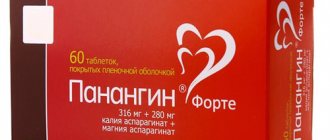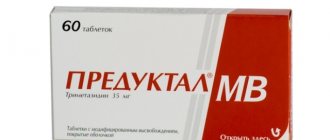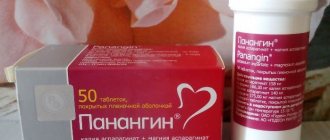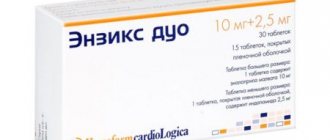A number of pathologies of the cardiovascular system are provoked by a lack of potassium and magnesium. Such diseases include arrhythmia, arterial hypertension and vascular stenosis. To compensate for the deficiency of microelements, you can use the drugs Panangin or Panangin Forte. However, you should consult your doctor before taking these medications.
To compensate for the deficiency of microelements, you can use the drugs Panangin or Panangin Forte.
Characteristics of Panangin
The product is produced in tablet form. Each tablet contains 158 mg of potassium aspartate and 140 mg of magnesium aspartate. The auxiliary composition is represented by the following ingredients:
- potato starch;
- magnesium stearate;
- povidone;
- titanium dioxide;
- silicon dioxide
The tablets are packed in blisters of 10 pcs. There are 5 blisters in a cardboard box. In addition, the drug can be produced in the form of a solution for injections.
The medicine compensates for the lack of magnesium and potassium in the body, and also stabilizes the frequency of contractions of the heart muscle. Its use makes it possible to normalize metabolism in myocardial structures and increase the susceptibility of cardiac glycosides.
The medication is often used as part of complex therapy for CHF, arrhythmia, and also to speed up recovery after a heart attack. In addition, it is prescribed for hypertension and deficiency of magnesium and potassium.
The drug is prohibited for use in cases of hypersensitivity to substances from its composition, urine retention and Addison's disease, cardiogenic shock, renal failure and hypotension.
The use of the product may cause the following negative consequences:
- from the cardiovascular system (marked decrease in blood pressure, deterioration of myocardial conduction, tachycardia, inflammation in arterial and venous vessels);
- from the central nervous system (decreased reflex functions, headache, muscle weakness);
- from the gastrointestinal tract (pain in the peritoneum, nausea, thirst);
- hyperkalemia;
- manifestations of an allergic nature in the form of angioedema, skin rashes and itching.
Panangin is prescribed for hypertension and deficiency of magnesium and potassium.
For heart pathologies, the medicine should be taken in a dosage of 2 tablets three times a day. For prevention, the dosage regimen must be halved. The duration of therapy depends on the patient's condition and the nature of the pathology.
Contraindications and side effects
The active ingredients of this drug are excreted by the kidneys, so it should not be used in case of renal failure.
If you have kidney problems, you should first consult a doctor.
It is prohibited to use the medicine in conditions of hypermagnesemia and hyperkalemia. Excessive dosage can also be very dangerous.
In this case, there is a disturbance in heart rhythm, high sensitivity, as well as endocrine problems. In some cases, side effects may also occur. For example, there may be abdominal pain, nausea and discomfort.
Sometimes dizziness, shortness of breath and decreased blood pressure may occur.
The drug is not recommended for people under the age of 18, as well as for pregnant women in the 1st trimester. The medication can only be prescribed by a doctor.
Action of Panangin Forte
This product contains potassium and magnesium ions. The components have the following properties:
- stimulate the functions of enzymes;
- stabilize the contractile functions of the heart;
- normalize metabolic processes occurring in the myocardium.
Aspartate is used as a conductor of potassium and magnesium ions in the medicine. It is similar to the structures of cells.
The use of the drug minimizes the likelihood of developing hypertension, arrhythmia, angina pectoris and ischemic conditions in the myocardium.
Pharmacological properties
Pharmacodynamics
Potassium and magnesium are the most important intracellular cations. They play an important role in the work of many enzymes, in the mechanism of muscle contractility, in the formation of connections between intracellular structures and macromolecules.
The ratio of magnesium, potassium, sodium and calcium ions inside cells and in the extracellular space affects the contractility of the heart muscle. Endogenous aspartic acid is a conductor of ions: due to the slight dissociation of its salts, it promotes the penetration of ions (in the form of complex compounds) into the cell.
Magnesium aspartate and potassium aspartate improve the metabolism of the heart muscle. With a lack of magnesium and/or potassium ions, the susceptibility to the development of conditions and diseases such as atherosclerosis of the coronary arteries, arterial hypertension and metabolic changes in the myocardium increases.
Pharmacokinetics
Magnesium aspartate and potassium aspartate are actively absorbed from the gastrointestinal tract, mainly in the small intestine.
Potassium and magnesium are excreted by the kidneys.
What is the difference and similarity between Panangin and Panangin Forte?
The drugs have common features. Among them:
- identical active ingredients;
- similar pharmacotherapeutic effects;
- similar indications for use;
- identical restrictions on use and adverse reactions.
Medicines differ from each other in the dosage of active ingredients. The medicine Forte contains twice as much potassium and magnesium aspartate. In addition, Panangin has 2 dosage forms - injection solution and tablets.
Side effects and symptoms of overdose
If you take the drug uncontrollably or do not follow the doctor’s instructions, side effects or overdose symptoms may occur. These signs include:
- gagging;
- pain in the epigastric region;
- convulsions;
- pale skin;
- feeling of thirst;
- respiratory dysfunction;
- muscle weakness.
You should listen carefully to how you feel during treatment. Signs of an overdose of magnesium and potassium may include:
- disturbance of consciousness;
- muscle weakness;
- feeling overwhelmed;
- fast fatiguability;
- feeling of goosebumps on the skin;
- fatigue.
In especially severe cases, a coma may occur or the patient will fall into a lethargic sleep. Elimination of overdose symptoms requires symptomatic treatment. Sometimes you have to resort to hemodialysis.
What is better to take - Panangin or Panangin Forte?
Panangin Forte contains 2 times more active ingredients, which allows you to reduce the number of tablets used. This remedy is used in the treatment of pathologies of the cardiovascular system. Classic Panangin is best used for prevention.
Panangin Forte is used in the treatment of pathologies of the cardiovascular system.
Compound
The Latin word fortis is translated into Russian as strong or strong. This means that medications with the forte prefix are more effective. This is due to the difference in composition.
Panangin Forte contains:
- 280 mg potassium aspartate;
- 316 mg magnesium aspartate.
While simple Panangin contains:
- 140 mg magnesium aspartate;
- 158 mg potassium aspartate.
As can be seen from the description of the composition, simple Panangin contains half as many active ingredients as compared to its analogue with the Forte prefix. The difference in auxiliary components is insignificant.
Doctors' opinion
Svetlana Zemtsova (cardiologist), 40 years old, Pushkino
These medications contain potassium and magnesium. These minerals are required for the stable functioning of the heart muscle. Medicines normalize the flow of nutrients and oxygen into the muscles. Their use helps strengthen blood vessels and minimize the risk of blood clots. If Panangin is used for prophylaxis, then cardiac ischemia, angina and arrhythmia can be avoided. At the same time, the medications have minimal contraindications and extremely rare negative reactions.
Evgenia Velochesova (cardiologist), 49 years old, Moscow
The drug Panangin and a similar drug with the designation Forte compensate for the lack of potassium and magnesium in the body. Their deficiency can lead to deterioration of myocardial conductivity, which will lead to the development of various cardiovascular pathologies. These medications prevent blockage of blood vessels, the development of atherosclerotic and age-related changes in the structure of the arteries. Drugs in this line are often included in complex therapy for myocardial infarction, angina pectoris and hypertension.
Drug interactions
Simultaneous administration of potassium supplements and glucocorticosteroids eliminates hypokalemia caused by glucocorticosteroids.
Combined use with beta-blockers, angiotensin-converting enzyme inhibitors, potassium-sparing diuretics, non-steroidal anti-inflammatory drugs, heparin and cyclosporine increases the likelihood of hyperkalemia, including asystole and arrhythmia.
Potassium and drugs containing it help reduce unwanted side reactions of cardiac glycosides.
Panangin Forte enhances the negative bathmotropic effect (decreased cardiac excitability) and the negative dromotropic effect (deterioration of cardiac conduction) of antiarrhythmic drugs.
Magnesium reduces the therapeutic effect of tetracycline, streptomycin, polymyxin B and neomycin.
Anesthetic agents enhance the inhibitory effect of magnesium-containing drugs on the central nervous system.
Concomitant use with dexamethonium, atracurium, suxamethonium and succinyl chloride may lead to increased neuromuscular blockade.
Calcium supplements reduce the effectiveness of magnesium-containing products; Calcitriol increases plasma magnesium concentrations.
Medicines that have an enveloping and astringent effect reduce the absorption of magnesium and potassium aspartate from the digestive tract, so the interval between taking such medicines and Panangin Forte should be at least 3 hours.
Panangin Forte: instructions for use, reviews, difference from Panangin
In some cases, the body may need additional supplies of some nutrients. A similar situation can simply occur during the off-season, when the amount of fruits and berries in the diet decreases. Also, deficiency of certain elements often occurs in certain diseases. Thus, cardiologists often prescribe potassium and magnesium supplements to their patients. The source of these substances is Panangin Forte (PF). The topic of our conversation today will be the instructions for use of Panangin Forte, we will also look at real reviews about the use of this drug, and find out what is its difference from Panangin.
Potassium and magnesium are extremely important for the proper functioning of the heart and blood vessels. In addition, these substances are necessary for the conduction of nerve impulses. They also maintain high elasticity and strength of vascular walls. Potassium and magnesium also play an important role in preventing the formation of vascular plaques. These elements benefit the body not only in combination, but also on their own. Thus, magnesium is important for the growth and functionality of joints and muscles, and this substance also enhances bone mineralization. In addition, this element helps maintain the proper amount of calcium in the blood.
Potassium is extremely important for stabilizing the water-salt balance. In addition, this substance performs transport functions and ensures proper tone and functioning of muscle fibers.
When is Panangin Forte prescribed?
?
PF can be used as a component of complex therapy. Thus, this drug can be prescribed to patients with chronic heart diseases, including heart failure that developed in the post-infarction period. This medication is also often prescribed for the correction of rhythm disturbances, especially ventricular arrhythmias.
Panangin forte is also often recommended for use in parallel with cardiac glycosides.
Sometimes this medicine is prescribed to people who do not have any cardiovascular diseases to saturate the body with potassium and magnesium.
How to take Panangin forte correctly
?
This medicine is intended for oral consumption. The tablets of the drug are swallowed without chewing or in any way violating their integrity. It should be taken soon after a meal, since the acidic environment of the stomach can reduce the effectiveness of PF.
The optimal dosage of this drug for adult patients is one tablet at a time. Reception is carried out three times a day. You should not use more than three tablets per day at a time.
Can the medicine cause side effects?
?
Panangin forte is usually well tolerated by the body. Sometimes this medicine may cause nausea, vomiting, and diarrhea. With gastritis or cholecystitis, PF can cause discomfort and burning in the epigastric area.
Manifestations of hyperkalemia (nausea, vomiting, diarrhea, paresthesia) or hypermagnesemia (redness of the face, sensation of thirst, decreased blood pressure, etc.) may occur.
Those readers of Popular About Health who notice side effects from taking Panangin Forte should seek medical help.
The difference between Panangin forte and Panangin
?
PF contains a larger number of active components. Thus, this drug is a source of 350 mg of magnesium aspartate hemihydrate and 332 mg of potassium aspartate hemihydrate, and one tablet of ordinary Panangin contains 175 mg of magnesium aspartate hemihydrate and 166 mg of potassium aspartate hemihydrate.
Some users claim that regular Panangin is more convenient than Forte, as it is available in bulk in a compact plastic bottle. Therefore, it is convenient to carry. Panangin Forte is sold in blisters, which in turn are packed in cardboard boxes.
If we talk about the cost of drugs, then PF costs approximately twice as much as ordinary Panangin, which is largely due to the presence of a larger volume of active components in its composition.
Reviews of Panangin Forte
The girl Lyubovnaya Lyubov from Ryazan writes that she was prescribed PF after detecting negative manifestations on the ECG. The doctor prescribed taking one tablet three times a day for twenty days. And after completing the course of treatment, the patient’s ECG became ideal. The girl did not experience any side effects.
The Tanja-nev girl from Rostov-on-Don started taking Panangin Forte tablets due to constant cramps in her legs. She needed to take this medicine three times a day, one tablet. The girl writes that the tablets look very large and it is not easy for her to swallow them. A course of taking the drug allows her to cope with the problem of seizures and prevent their occurrence six months in advance.
Alder user from Chelyabinsk was prescribed Panangin Forte to correct heart rhythm disturbances, which in turn develop while taking hormonal drugs (Eutirox). In just a year, a woman takes four courses of taking this medicine (twenty days each), which allows her to improve her health: get rid of interruptions in heart function, feel lightness in her legs and improve performance.
Thus, Panangin Forte is a fairly effective drug. But you should take it only after a doctor’s prescription.
PF can be used as a component of complex therapy. Thus, this drug can be prescribed to patients with chronic heart diseases, including heart failure that developed in the post-infarction period. This medication is also often prescribed for the correction of rhythm disturbances, especially ventricular arrhythmias.
Indications and composition
Many experts note that the composition of Panangin includes a vitamin complex. The main component of the product is potassium, combined with another active element - magnesium.
The drug is used if there is a deficiency of these components in the body, which negatively affects the functioning of the heart. The elements that make up the medicine eliminate this problem and restore the normal functioning of the system.
Also, the drug is used in the development of diseases such as:
- tachycardia;
- arrhythmia;
- myocardial infarction;
- ventricular arrhythmia.
While taking the drug, the epithelial cells are filled with the necessary amount of potassium and magnesium. It is this “combination” of elements that is most suitable for the prevention and elimination of heart diseases.
The drug is produced in the form of pills and solution for injection. Before purchasing the drug, you should consult a doctor, as side effects may occur during use.
It is worth noting that the pharmaceutical company creating this medicine also produces another type called Panangin Forte. The main difference between these two products is the amount of microelements present in the composition.
Contraindications
The action of tableted Panangin Forte and Panangin is the same, so the list of contraindications is similar:
- insufficient kidney function;
- hypermagnesemia;
- increased potassium content;
- atrioventricular blockade;
- hypotension (upper blood pressure below 90);
- erythropoiesis (decrease in erythrocyte count caused by massive destruction of blood cells);
- autoimmune lesions of muscles or nervous tissue;
- individual intolerance to the components of the drug.
Conditional contraindications include pregnancy, breastfeeding and age under 18 years. This is due to the fact that there is no clinically proven data on the safety of the drug for this group of patients.
To the above list, the following are added to the contraindications for the injection form of Panangin:
- swelling;
- impaired liver function;
- urolithiasis.
Injections are given only in a medical facility. If taking Panangin for prevention is acceptable without a doctor’s prescription (athletes who take the drug in courses during intense training), then injections are given only under medical supervision.
Dosage
Pills
Take 1-2 tablets. three times a day, but no more than 3 tablets at a time, after meals, because Empty stomach contents reduce the effectiveness of the drug.
The duration of use and the need for repeated applications are determined individually.
Injections
Used intravenously, by drip, as a slow infusion (~20 drops per minute): the drug from 1-2 ampoules is dissolved in 50-100 ml of glucose or dextrose solution 5%. Combination treatment with Panagin with other drugs with intravenous administration is possible.
Repeated administration - no earlier than 4-6 hours after the first dropper.
Side effects
When used internally, the following side effects are possible:
- from the cardiovascular system: paradoxical reactions, AV block;
- from the digestive system: vomiting, nausea, diarrhea, epigastric discomfort in patients with cholecystitis or antacid gastritis;
- water and electrolyte changes: hyperkalemia, which is manifested by diarrhea, vomiting, nausea, confusion and paresthesia; hypermagnesemia, which is characterized by redness of the facial skin, thirst, drop in blood pressure, convulsions, and respiratory depression.
With rapid infusion, the symptoms of hyperkalemia or hypermagnesemia described above may develop. Phlebitis, AV block and paradoxical reactions may also develop.











